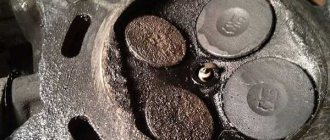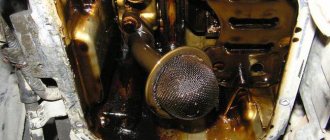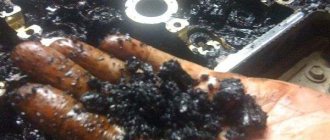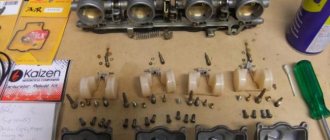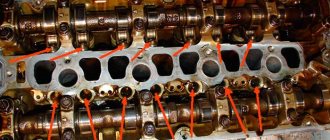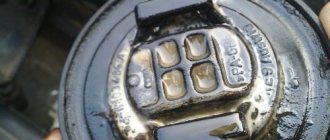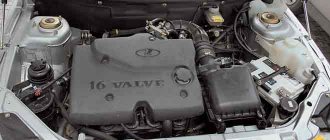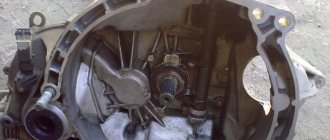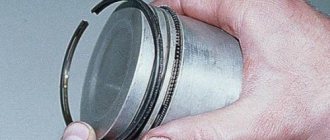Engine cylinders are parts in which constant combustion of the fuel mixture occurs, forming carbon deposits. Its removal is called decoking. Oil supply is carried out in two ways - using oil seals or piston rings. In the first case, you need to replace the unit; in the second, you can decarbonize the piston rings yourself .
- Decarbonization of oil scraper rings with kerosene, video:
A car service center will encourage you to overhaul the engine, but you can get by using preventive methods. By completing simple tasks to remove carbon deposits yourself, you will increase your car's mileage by 30-40 thousand km and will not lose money on replacing parts.
There is a similar article on this topic - Knock sensor: signs of malfunction, replacement.
Why is decarbonization necessary?
Decoking, that is, removing coke from parts or groups of parts, is the cleaning of their surfaces, which greatly affects their proper operation.
It’s like personal oral hygiene; in order to prevent contamination, periodic preventive cleaning is required. The same must be done with engines.
Not many people know that it is necessary to clean the parts of the CPG (cylinder-piston group), parts of the crank mechanism (crank mechanism).
Even if we take a purely physical look at a burnt piston, we will immediately see that there is a layer of deposits on the surface that reduces the working volume of the combustion chamber. And coked rings can become stuck and not move, thereby reducing cylinder compression. Plaque on the valves does not allow them to fit tightly into their seat, thereby leaving the hole open. This results in increased engine oil consumption, scuffing and scratches on the cylinder bore, valve burnout, and a drop in engine power. And this all leads to the unloved overhaul of the engine.
To extend the life of the engine, it is necessary to decoke the internal combustion engine parts, remove carbon deposits from the pistons, loosen and stir the oil piston rings and clean the oil drainage channels.
Cleaning parts from time to time, especially if low-quality fuel is used. This will eliminate the engine detonation that sometimes appears, and the compression in the cylinders will be equalized. But if blue smoke appears from the muffler, it means engine oil is getting into the combustion chamber. Here you need to look for the reason for the oil ingress.
There are so-called soft and hard decarbonization groups.
Assessing the condition of the rings
During engine operation, heavy carbon deposits may form on the cylinder rings.
There are two main reasons for this:
- use of low-quality fuel or;
- penetration into the combustion chamber of motor oil.
In small quantities, such deposits have almost no effect on engine performance. In the future, the following problems are possible, indicating coking :
- reduction in engine power;
- reduction of compression;
- occurrence of detonation;
- difficulties at start;
- decreased sensitivity of the gas pedal;
- increased oil consumption;
- the appearance of smoke coming from the chimney;
- the appearance of oil deposits on the spark plugs.
The listed manifestations indicate the need to cleanse the rings. In the most severe cases, deformation is possible due to detonation of rings and even pistons.
Causes and consequences of carbon deposits in the engine
As noted above, there are three main reasons for the formation of carbon deposits on the piston rings and in the combustion chamber: oil getting into the combustion chamber, the use of low-quality fuel and (or) motor oil that is unsuitable for a given engine.
Of course, it is impossible to determine the quality of fuel “by eye,” so absolutely all car owners are at risk – especially those who refuel at small gas stations outside the city. It’s easier with oil - just buy it at trusted retail outlets or contact specialized service centers for a fluid change. When choosing oil yourself, you should take into account all the manufacturer’s recommendations.
An engine that is not warmed up in winter, driving at low speeds, regularly sitting in traffic jams - all this also contributes to the intense formation of carbon deposits on the walls of the combustion chamber and engine parts: valves, bottom and piston walls.
If you do not decarbonize the piston rings in a timely manner, the engine will begin to wear out many times faster.
Let's highlight the most common consequences of engine coking:
- A thick layer of carbon deposits on the cylinder walls impairs their thermal conductivity and increases the thermal load on the engine.
- In a contaminated combustion chamber, detonation phenomena occur and, as a result, pressure surges
- Carbon deposits on the piston rings reduce the gap between them and the valve walls, as a result of which the tightness of the combustion chamber is compromised and compression deteriorates; rings stop moving and may break due to extremely high load
- Due to slag getting under the valves, they do not fit tightly into the seat and can burn out
- Fuel and oil consumption significantly exceeds the norm due to the occurrence of rings
Reasons for ring coking
There are a large number of different reasons that can lead to coking of piston rings.
Among them:
- driving short distances in winter and off-season;
- failure to comply with the deadline for timely replacement of automobile oil;
- engine overheating;
- use of low-quality motor oil;
- idle car in winter;
- use of different additive compounds;
- engine operation in conditions of increased heat;
- low quality fuel;
- penetration of oil into the cylinders during incomplete combustion.
The reasons for engine oil getting into the cylinders are a separate topic. Decarbonization is a standard preventative measure.
If you do not want to regularly decarbonize the rings, you should eliminate the very cause of the carbon deposits.
The main possible causes of soot :
- wear or damage: the oil scraper ring located at the bottom is not able to remove excess oil from the cylinder, so an increasing amount of compound slowly accumulates inside the grooves, which burns and leaves a black coating;
- wear or damage to oil scraper caps needed to eliminate excess;
- small scratches or distortions on the cylinder mirror, which become places where engine oil accumulates;
- using low-quality or old motor oil: over time, it loses its fluidity, which makes it difficult to remove residues from the mirror surface.
When is decoking necessary?
Modern inspection and repair of the engine, if necessary, is the key to its long and reliable operation.
At the first signs of problems with the power unit - a noticeable decrease in operating power, excessive consumption of fuel or oil - it is necessary to take action.
Decoking of piston rings is really necessary in cases where:
- Increased oil consumption
- When starting the engine, there is a strong exhaust and an unpleasant smell of combustion products penetrates into the cabin.
- The dynamics of the car are sharply reduced
- In the absence of any problems with the battery, the engine is difficult to start in sub-zero temperatures
- Engine idles irregularly
How to choose piston rings
The selection of piston rings means that the dimensions of the piston rings must necessarily correspond to both the dimensions of the pistons and the dimensions of the cylinders. Let us add that selecting piston rings by size is a little easier compared to selecting the pistons themselves. This is due to the fact that repair piston compression and oil scraper rings for various engine models are more or less interchangeable today. This means that you can purchase both original piston rings and select parts from a third-party manufacturer.
Selection of rings by size
It is necessary to select rings taking into account the following basic parameters:
- piston ring height;
- piston ring diameter;
Any high-quality analogue that has the required dimensions often becomes available without any problems. To be completely sure, it is also necessary to take into account the radial width of the piston rings, or rather, the correspondence of this width to the piston grooves. In other words, the depth of the grooves in some cases may be insufficient.
As for compression rings, such rings are structurally similar, often have the same or almost the same radial width, so problems usually do not arise after installing correctly sized rings from this group. The selection of oil scraper rings, on the contrary, requires increased attention both to the design of the ring itself (box-shaped, stacked oil scraper rings), and additional clarification of their radial width according to special catalogs of the ring manufacturer.
I would like to add that selecting piston rings for diesel engines is more difficult. Compression rings for diesel engines are molybdenum coated and also have a trapezoidal profile, which can additionally have different angles. Oil scraper rings in diesel engines are usually box-shaped, but this fact must also be checked in catalogs, since there are cases of installation of set rings on a diesel engine.
Please note that it is highly not recommended to install piston rings from a gasoline engine on a diesel engine. At the same time, in some cases, it is possible to install piston rings from a diesel engine to a gasoline engine
Which piston rings are better
In addition to choosing from the available nominal and repair sizes of rings, you will also need to separately select the material of manufacture. It is quite fair to say that piston rings for a low-power, low-speed engine, which was developed 10-15 years ago (even taking into account their full compliance in size), will be able to function normally and for a long time in a highly accelerated turbocharged power unit.
The fact is that the materials, coating applied and tolerances on the geometry of the rings may well differ
During the selection process, close attention should be paid to these factors, especially in the absence of accurate data in the manufacturer’s catalogs. It should also be added that rings for new engines usually work well in older internal combustion engines, but not vice versa
The upper ring is the most heavily loaded during the operation of the internal combustion engine. For this reason, such rings are made of alloy cast iron, which is also plasma sprayed with chromium or molybdenum. Chrome has a porous structure, which allows it to effectively retain the required amount of engine oil. Coating with chromium or molybdenum increases the wear resistance of the rings and also provides a low coefficient of friction during contact with the cylinder walls.
Cast iron piston rings are considered to be of sufficient quality. Such parts are made of high-strength cast iron, which has improved properties and actively resists wear. Oil scraper rings are available in chrome plated and also without chrome coating. Steel rings additionally equipped with a spring element are also on sale.
Chrome rings are usually installed on engines with a high compression ratio, which implies more severe loads on the internal combustion engine and CPG. Foreign-made civilian cars often have stainless steel piston oil rings. Such rings are characterized by a long service life, low weight and reasonable cost.
The best ways to decarbonize
Using special means, it is possible to completely eliminate combustion products, which prevents the need for major engine repairs.
At some point, any engine will experience loss of power. One of the main reasons for this problem is heavy carbon deposits in the piston grooves - coking of the engine.
There is no common position among car enthusiasts regarding the advisability of the decarbonization procedure of a car engine. Some believe that decoking of rings is an effective method of cleaning internal voids and engine parts from carbon deposits, while others have a negative attitude towards this procedure.
Today, quite a few decarbonization methods are used. Some of these methods have been known for a long time, while others arose relatively recently. They are conventionally divided into hard and soft .
Soft methods include the use of liquids produced by the modern chemical industry. They can be added to fuel or mixed with oil. This composition is added 100 km before the scheduled oil change. The engine is cleaned while the car is moving. It is unacceptable to create a significant load on it throughout the entire cleaning period. Typically, cleaning is carried out during the mileage, and after completion, the engine oil is replaced and the engine is washed with a special substance.
Decarbonization video
Despite its simplicity, this method does not make it possible to completely clean the engine by removing carbon deposits. Its validity period is limited.
The most effective is hard cleaning , which was used for old engines.
Its essence is the introduction of a special aggressive substance into the internal combustion chamber. This leads to corrosion and softening of carbon deposits. To flush the entire engine and remove carbon deposits from both the cylinders and valves, a kerosene-acetone mixture is suitable.
Decarbonization of rings with kerosene
Decarbonization using kerosene mixed with acetone is an “old-fashioned” method that has proven its effectiveness on old VAZ engines. Nowadays, the kerosene-acetone mixture is often improved by introducing oil or other chemicals into it.
To prepare the liquid, you need to take into account that its quantity should be approximately 150 milliliters per cylinder. A small amount of oil is poured into the combustion chamber, similar to other products in this category, which enhances the effect and does not allow it to evaporate quickly. This leads to reduced oil consumption, improved dynamics, and prevents detonation resulting from incomplete combustion of the combustible mixture.
An oil change must be mandatory, since acetone and kerosene are aggressive towards oil. For this reason, the lubricant must be replaced at the end of the procedure. During the first start-up, it is advisable to install out-of-date spark plugs while burning off the remaining carbon so that the new ones do not deteriorate.
Decarbonization without oil change
The above methods differ in that an oil change is necessary immediately after completion of the procedure. If you don’t want to do it, you can use certain additives for gasoline or diesel fuel and carry out decoking without changing the oil.
The main function of additives is to remove substances resulting from combustion using a special chemical composition that penetrates into the fuel cylinder and reduces the volume of carbon deposits, as well as removing existing ones. Their advantages:
- ease of use (you just need to fill it);
- no need to dismantle spark plugs and change oil;
- the appearance of a protective film on the surfaces of the cylinders.
The method without changing the oil is suitable for removing only a small amount of carbon deposits (with a significant amount, additives are ineffective). Its disadvantage is the slow achievement of results. The effect can be noticed only after traveling several hundred or even thousands of km.
Removing carbon deposits with water
Some motorists have learned to use a milder procedure that has the same effect in removing carbon deposits as chemicals. Decarbonization with water is the most common method that owners of domestic and imported cars decide to use.
For the procedure you will need:
- distilled water in a plastic bottle;
- dropper;
- hose (for windshield washer);
- tee (connect the washer).
The scheme of work is as follows: water from a bottle is connected through a dropper to the engine suction. You can use non-distilled water - the filtration system in the dropper itself will handle the cleaning. Water supply starts with the engine running - at approximately 2000 rpm.
2-3 drops per second is enough when the engine is idling when the engine is warm. The effect will not take long to appear, the carbon deposits are removed, and the car becomes dynamic and economical.
Video
Decarbonization of a Mitsubishi engine using Lavr ML-202.
This video shows the results of the decarbonization test.
The best engine decarbonization for 50 rubles.
Step-by-step instructions for carrying out work
The decarbonization procedure usually does not present any difficulties for an experienced car enthusiast and is carried out in the following order :
- The car warms up to the operating temperature with mandatory installation in a horizontal position.
- The spark plugs (when the engine is on gasoline) or the injectors or glow plugs (when the engine is diesel) are unscrewed.
- When turning the crankshaft clockwise using a ratchet, each piston is set to the middle position.
- The decarbonizing composition is poured into the combustion chamber for a while (indicated in the instructions). You should wait from one to two hours or leave the composition in the engine overnight. To avoid evaporation, nozzles or candles are placed in the holes.
- After the required time has elapsed, the candles or nozzles are unscrewed and the holes are covered with a rag. Then the crankshaft is cranked using the starter for five to seven seconds. In this way, the remaining composition and softened carbon deposits are removed.
- Then the spark plugs or injectors are installed back, the engine starts and runs at idle for five to ten minutes.
- The filter and oil are replaced.
- If necessary, the procedure can be repeated after covering 50-100 kilometers.
Decarbonization process. Old-fashioned methods
Over many years of operation, internal combustion engines have learned to restore the cleanliness of the piston group and combustion chamber in several ways. The most “old-fashioned”, undoubtedly, can be considered the attempt to clean everything with a mixture of kerosene and gasoline. Gasoline in the mixture is not for better combustion, but so that the kerosene does less harm to the rubber parts of the engine.
It is enough to pour the mixture into the cylinders and occasionally “move” the engine, turning the crankshaft back and forth to facilitate the passage of the mixture to the piston rings. Hold it as long as possible, then crank the engine with the starter, and the remaining decoking mixture along with the dissolved dirt will fly out. A little of the mixture will enter the crankcase and evaporate later.
The method is quite popular even now, since the components are available to anyone, and all the tools you need is a spark plug wrench. But its efficiency is extremely low, because it was designed for washing relatively low-temperature ash, and the process had to be repeated literally every couple of months. Modern engines have completely different carbon deposits: hard, high-temperature, even if it occurs due to oil entering the combustion chamber.
Decarbonization with water, also known as decarbonization with alcohol, turned out to be a much more exotic method. Once upon a time, people noticed that on engines that were injected with a water-methanol mixture during afterburner, the piston and combustion chamber simply shone. The search for the cause pointed to water - it is responsible for cleaning the combustion chamber. A shock dose of steam has an excellent effect on all deposits, because water is a universal solvent. And the combination of H2O+O2 is generally a lethal thing at high temperatures. Of course, the steam does not penetrate too deeply, but where it does penetrate, it literally knocks away layers of layers from the metal. And they already fly further with exhaust gases.
On a carburetor engine, the decarbonization process usually consisted of mixing gasoline and vodka in a 1 to 1 ratio and supplying the mixture to the carburetor inlet. Then everything is simple: the “choke” was turned on, and the motor sucked in the mixture. An hour of idling or leisurely movement - and the unit is clean. You can drive further, but often the operation was carried out before major repairs, so as not to wash the parts manually.
Technology for decarbonizing car engine piston rings without disassembling the unit
Decarbonization can be done in two ways: mechanical and chemical. The first option is very labor-intensive and is performed exclusively on a disassembled motor. If carried out, it is combined with a major overhaul. The second way is based on the use of various chemicals.
How it is produced
Decarbonizing the engine with chemicals gives quick results. The principle of its implementation is the same regardless of the type of composition used. Detailed instructions include the following transitions:
- Warm up the engine.
- Unscrew the spark plugs.
- Move the pistons to the middle position.
- Pour the decoking mixture into the cylinders.
- Wait a while (the duration of the process depends on the type of auto chemical used).
- Pump out the remaining liquid from the “pots”.
Decarbonizing composition of branded production
The assortment of a large auto retail chain offers a fairly large number of detergents for removing carbon deposits. They propose to remove and dissolve coke in the combustion chamber over different periods of time. The bill for payment is also different - there are budget drugs, there are also expensive ones.
A qualified seller will definitely ask about the desired degree of aggressiveness of the product. It all depends on the mileage and the degree of neglect of the closed chamber. There are soft and rough compositions. When choosing a composition, you should focus on the top representatives of the niche:
- Misubishi SHUMMA - rough (1,500 rubles).
- XADO Verylube – hard (800 rubles).
- Greenol REANIMATOR – coarse (900 rubles).
- GZox – soft (500 rubles).
- Kangaroo ICC 300 – soft (400 rubles).
Before purchasing, you need to familiarize yourself with the features of the engine, read reviews about decoking of piston rings of a certain engine model without disassembling it, and carefully study the instructions. For example, GZox is not recommended to come into contact with alusil coating, which is often applied to the cylinders of units of modern foreign cars.
Homemade decoking preparations
Alternative functionality can be provided by household or pharmacy products at an affordable price. An experimental popular base has been developed regarding their use. Photo reports show that well-chosen proportions allow you to achieve excellent cleaning results.
Solvent decarbonization of the engine
The solvent is a light hydrocarbon. It is obtained both from coal and gas, and from oil. The most aggressive properties are coal-based nefras, which has a yellowish tint. However, clear liquids obtained from petroleum products also clean well.
Practice shows that 20 cubes of solvent per cylinder is enough in cases where compression is normal, but the engine is already starting to eat up oil. The portion is poured for 0.5 hours. After filling, you immediately need to turn the crankshaft 20-40 degrees in one direction, then in the other, so that the drug gets to the rings faster.
Compression problems are more serious and can be corrected with continued treatment. It is enough to inject 100 ml per cylinder and leave the mixture for 4-5 hours. The presence of liquid in the “pots” must be monitored and topped up, since it eventually goes into the crankcase.
Engine decarbonization with kerosene
Kerosene liquid is colorless and is obtained by direct distillation from petroleum. Coke cleaning alone is ineffective. A mixture of kerosene and acetone in a 1:1 ratio has more aggressive properties. 50 ml of the composition is poured into one cylinder. Staying time – 12 hours.
Decarbonization with kerosene does not produce the desired effect on running engines due to its low solvent properties. Reviews compare this method with soft branded products and are prescribed at the initial stage of oil burns and loss of compression.
Dissolving carbon deposits with dimexide
Dimethyl sulfoxide is a pharmaceutical anti-inflammatory drug. Sold in tubes of 100 ml. Price – about 50 rubles. In fact, it turned out to be a strong solvent of various deposits. The drug is prescribed for use on engines with an impressive amount of coke in the piston grooves.
This product should be used with caution. According to reviews of the drug:
- Crystallizes at temperatures below 18.5°C.
- Peels paint.
- Destroys plastics.
If there are no plastic elements in the power plant, the enamel has been removed from the pan and dipstick, the work is carried out in a heated garage or during the hot season, and the instructions on how to properly flush the engine with dimexide are followed, then there is nothing to fear.
Risks
It’s understandable that there are positive changes, but there are also chances for negative developments? In addition to the predicted risks of contamination of spark plugs, catalysts and other things, there is also a non-zero chance of getting a piece of coke directly under the piston rings and a scratch on the cylinder bore. Or a large piece of carbon directly under the valve, which can lead to its failure or a collision between the valve and the piston. Fortunately, the chance of this kind of trouble is small, but you shouldn’t forget about this possibility.
About decoking with water, it is worth saying that when using it, the risk of water hammer is quite high, especially if the procedure is carried out carelessly. Many services simply do not take on this work if they are not confident in their abilities.
Decarbonization with Laurel, kerosene and acetone
How to choose piston rings
Do-it-yourself decarbonization is a time-tested technology. The cheapest and crudest method would be to decarbonize the rings using the ancient old method - kerosene, solvent, acetone. This is done using the following technology:
- mix 50% acetone or solvent, 25% kerosene and the rest is achieved with liquid oil
- for winter or diesel;
- candles are turned out;
- the resulting mixture (about 100-120 g) is poured into the cylinders;
- old candles were screwed in or the holes were simply plugged;
- the engine is cranked by the starter several times;
- the mixture is left in the cylinders for 2-3 hours;
- wash the cylinders with a mixture of gasoline and engine oil;
- After this, be sure to let the engine run under load for half an hour on a warm engine with the throttle valve fully open.
As a rule, after this operation there is no trace left of coke and soot. This is how they did it before. However, the most correct and effective decarbonization is engine disassembly and mechanical cleaning, and means for decarbonization without changing the oil can be considered simply as a half-measure.
Today, a lot of manufacturers offer mixtures for decoking: Laurel, Hado, Surm, Edial, but you should not blindly trust these compounds, because it can only get worse, and much worse. Although, this is a topic for another conversation, but for now, watch the compression, pour good oils and good luck to everyone!
Mitsubishi Shumma Engine Conditioner
The Japanese engine decarbonizer, according to many experts and experienced drivers, demonstrates the best results. It dissolves carbon deposits or softens it, making it easy to remove mechanically.
Shumma is petroleum based, contains 20% ethylene glycol and monoethyl ether, looks like foam and smells like ammonia. This cleaner was developed for severe decoking of GDI engines (direct injection), but can be used in any type of power unit.
It is injected into the cylinders through a tube and left for at least 30 minutes (preferably 3-5 hours). The composition is not aggressive towards valve stem seals.
One Shumma cylinder is enough to clean one 1.5 liter engine. The decarbonizing agent does an excellent job of removing carbon deposits on pistons, rings, valves and combustion chamber surfaces. Can be used both for pouring into the engine without disassembling, and for soaking parts.
The price of Shumma is quite high, but justified by its performance properties. If this remedy does not produce results, we can say with confidence that only repair will help.
Why is oil intensively consumed?
In a working engine, valve stem seals and rings are responsible for removing residual lubricant from the valve stem and cylinder walls, respectively. At high speeds, the performance of this process decreases, but in general, oil consumption does not exceed the norm prescribed by the manufacturer. For some it is 1 l/10,000 km, for others it is 0.3 l/10,000 km, and still others may not add anything at all between service intervals, since they do not turn the engine above 3,500 rpm.
Naturally, when lubricant consumption suddenly increases, say, to 1 l/1,000 km, and even blue smoke comes out of the exhaust, this is a signal of a violation of the oil scraper functions. There are several reasons for this:
- The oil scraper rings are stuck.
- The caps have become stiff.
- The valve guides are worn out.
As a result, it would be nice to determine without disassembly which particular group of parts failed. Whether this is possible is the topic of the next paragraph.
Gzox Injection & Carb Cleaner
Depending on the method of application, the substance cleans the combustion chamber, decarbonizes piston rings or removes carburetor deposits. The chemical composition of the product helps to achieve instant dissolution of carbon deposits, resins and formations based on them - which restores the mobility of oil scraper rings. Car enthusiasts who have used GZOX INJECTION to restore engine performance note the high efficiency of the substance, which, after cleaning, returns the engine to stable operation and increases throttle response. As practice shows, when decoking is carried out according to the instructions, the result will only be positive. There is no restorative effect, so a diagnostic error or an indication of wear on the oil scraper rings may occur. The manufacturer recommends completely cleaning the lubrication system and changing the oil after using the substance.
Liquid for engine decarbonization - how to carry out the operation?
The most common is the hard method, which involves decoking the engine with water, kerosene and acetone. Water is mixed with special additives to remove carbon deposits. When using kerosene and acetone, the engine must be warmed up to operating temperature, then unscrew the spark plugs or remove the injectors. All pistons should be set to a position as close as possible to the average.
The cleaning liquid is poured directly into the combustion chamber and remains there for a certain time, depending on the degree of contamination. After cleaning, the fluid is removed by turning the crankshaft using a starter. At the end of the procedure, you need to tighten the spark plugs, start the engine and let it run at various speeds, followed by a mandatory oil change.
In modern conditions, a special liquid is used to decarbonize the engine, which allows this procedure to be carried out while the car is moving. It is poured into the car's fuel tank and enters the combustion chamber along with the fuel. Thus, complete burnout of all deposits occurs, and their remains exit through the gas exhaust system. This method is the simplest and most economical, not requiring special skills or tools. It is this method that gives the maximum effect.
Home →
Operation → Auto chemicals and auto cosmetics →
Lavr ML-202
One of the most famous domestic liquids for removing carbon deposits from pistons, rings and grooves without disassembling the engine. As real tests show, the product acts at the level of household solvents, while creating an even more aggressive environment.
Lavr ML202 Anti Coks Fast is a complex of surfactants and solvents of various chemical natures. Despite the fact that the product is positioned as an engine cleaner from tar, coke and carbon deposits without mechanical intervention, practice shows that carbon deposits remain after its use.
After using LAVR, the oil must be changed, so it is recommended to use it before scheduled maintenance. The instructions provide for pouring 45 ml of the drug into each cylinder. For express cleaning, it must be left for 30-60 minutes. In case of serious “symptoms” of rings being twisted, a minimum of 12 hours will be required. The maximum stay of liquid in the cylinder should be no more than 24 hours.
The liquid in the bottle is enough to decarbonize a power unit with a volume of just over 2 liters.
Is it possible to replace piston rings without removing the engine on a Chevrolet Niva
4.
We dismantle the expander.
5. In order to replace the piston, the retaining ring is removed.
6. After dismantling the two piston rings, the pin can be freely removed from the hole.
When performing work, it should be taken into account that some parts will also be in good condition.
If necessary, they can be reused by marking the positions with a pencil.
If it is necessary to replace pistons, it should be taken into account that their mass should not differ. The maximum deviation is only 2.5 grams in both directions.
You can check the mass using electronic scales, the accuracy of which is a fraction of a gram.
You need to unscrew one engine mount, jack up the engine, then you can unscrew the pan, there will be a problem with pulling out the pan - it will cling to the oil intake with the oil cooler, but in general it can be pulled out - I disassembled the engine myself. Good luck! Mitka 09.20.2001, 07:24 # NOT LISA! I unscrewed BOTH supports, unscrewed the bridge, jacked up the engine, a gap of 8 centimeters came out (between the loosened pan and the engine), but the pan did not come out. :(Can the engine be raised higher somehow? Quiet Don 09/20/2001, 07:32 # Ask Akela - he’ll tell you, it seems like you need to unscrew the oil pump through the crack and drop it into the pan, then everything will work out. Good luck. Oleg. ALER 20.09. 2001, 07:45 # Exactly. And put the T in reverse order.
Wynn's Combustion Chamber Cleaner
High-quality decoking helps to carefully remove carbon deposits, varnish deposits and sludge carbon formations in the CPG of gasoline engines only. The substance helps restore the mobility of oil scraper rings, as well as compression rings, and clean the intake manifold with valves. The product does not have a negative effect on the catalyst. The unusual use of the substance surprises car enthusiasts - it is supplied through the engine vacuum hose, but the high efficiency of the product is noted by equalizing compression in the cylinders, reducing vibrations and eliminating engine detonation. Many users note a minimal level of oil consumption, as well as a significant increase in engine power. The cleaning process does not require lubrication and practically does not harm the motor, since there is no contact with the rubber seals of the engine.
How to prevent carbon deposits
There are several ways to deal with soot. We won’t consider preventive measures yet, this is already clear, let’s just call them:
- timely oil change;
- compliance with manufacturer requirements for oil quality;
- use of high-quality gasoline;
- other preventive measures.
Oil manufacturers try to add additives to the oil that improve the cleaning characteristics of motor oil. This is what distinguishes good oil from bad one. Absolutely all viscosity parameters can be the same for both good and bad oil, but with cleaning properties - not so much. Therefore, the same oil manufacturers offer so-called decarbonization for rings and for the engine.
Edial
This substance enters the combustion chamber along with the fuel, so there is no need to unscrew the spark plugs - just pour the product into the neck of the gas tank and fill the fuel. The advantage of this procedure is that there is no need to change the oil and it is easy to use. After preparing the fuel mixture and decoking, the mobility of the compression and oil scraper rings is restored, and fuel consumption returns to the desired level. The engine begins to please with increased throttle response, as well as dynamics. Reviews from Edial users indicate the smoothness of the changes after treatment. The product also cleans injector nozzles in injection and diesel engines and removes deposits. As car enthusiasts say, Edial is a simple and effective remedy, the regular use of which significantly reduces the need for major repairs of the CPG.
Total
The purpose of decoking measures is to clean the combustion chamber of carbon deposits. Relevant for low compression, increased oil consumption and increased fuel consumption. The essence of the procedures is to pour the composition into the cylinders and give it time to dissolve the deposits.
The chemical cleaning method is preferable because it does not require disassembling the engine. You can use both branded decarbonizers and homemade ones. Among the traditional methods are decarbonization with solvent, kerosene and acetone and dimexide. Dimethyl sulfoxide has the most aggressive properties.
Options for engine protection against carbon deposits
To reduce the rate of deposit formation it is necessary:
- use motor oils with tolerances specified by the vehicle manufacturer;
- use high quality fuel and refuel the car at pumps of large oil refining companies;
- regularly change filters that remove impurities from fuel;
- reduce the number of trips with the power unit partially warmed up or with long periods of idle time in traffic jams;
- periodically go on the highway to drive at higher speeds, which allows you to partially remove deposits.
Engine decarbonization: a cheap solution to a big problem?
“I’m interested in the issue of decoking a gasoline engine from soot or when rings are stuck. I would like to know the nuances of how it works. What means should I use? Is it worth it?
Decarbonization is a method of in-place cleaning of an engine from carbon deposits accumulated inside its cylinders. However, when a working engine is operating, the process of carbon formation should occur under conditions of dynamic equilibrium: as much carbon appears, the same amount of carbon burns out. Therefore, in a working engine, carbon deposits are present only in the form of a thin layer covering the surfaces of parts in contact with combustion products, but cannot accumulate and impair the performance of the power unit.
Only when the car is used for very short trips and at low ambient temperatures, when the engine does not have time to warm up and operate for some time at normal temperature conditions, carbon accumulation occurs. However, this carbon burns out quickly, as soon as you drive your car out of town for at least 20-30 km.
In all other cases of increased carbon formation, problems in the engine itself are to blame. These may be malfunctions of the cooling system, which does not allow the engine to quickly warm up to operating temperatures, the power supply system or ignition, due to which incomplete combustion of fuel occurs. The exhaust gas recirculation system and the use of low-quality motor oil and fuel can contribute.
Finally, excessive carbon formation is observed when the valve stem seals and cylinder-piston parts are worn to the limit, due to which they no longer prevent the penetration of oil into the combustion chamber.
When carrying out decarbonization, special preparations are supplied inside the engine cylinders, with the help of which carbon deposits are removed, but one must understand that “chemistry” does not eliminate malfunctions that cause increased carbon formation. Therefore, decoking is not a panacea. Until the root causes of soot accumulation are identified and eliminated, decarbonization, if it helps, will not last long.
Whether it is worth resorting to this procedure is up to the car owner to decide. If for some reason he must drive a car that has defects, but not send it in for repairs, decarbonization makes a certain sense. Perhaps this procedure will not be superfluous after the fault was found and fixed, but the engine was not disassembled, which did not allow its parts to be cleaned of carbon deposits manually. We don’t see any other reasons for decoking, because, we repeat, in a working engine, as much soot appears in a working engine, the same amount of it should burn out.
Sergey BOYARSKIKH Photo by ABW.BY
You have questions? We have the answers. Topics that interest you will be expertly commented on by either specialists or our authors - you will see the results on the website abw.by. Send questions to the address and follow the site
Common myths about decoking
Despite the start of mass production of synthetic oils and improved fuel quality, engines become contaminated with deposits because the clearances between mating parts are reduced. Carbon deposits reduce compression and lead to increased fuel and lubricant consumption. But it should be remembered that decoking will not restore the performance of a power unit with worn rings and cylinder mirrors.
The maintenance procedure depends on the configuration adopted for the cylinder block. With an inclined arrangement of combustion chambers, it is necessary to fill in a larger volume of cleaning agent than with a vertical arrangement (with the same displacement and number of cylinders). At the same time, it should be taken into account that excess solution should not be filled, since the penetration of the reagent into the oil pan through the piston ring locks leads to damage to the seals.
Reagents should not clean parts to their original factory condition; excessive aggressive action leads to the formation of cavities on the metal surface. The remaining liquid poured into the cylinders burns and forms a smoky exhaust, which is not a sign of an emergency condition of the engine and does not harm the catalytic converter or soot trap. Owners with experience in decarbonizing power units recommend changing the oil immediately after completing the cleaning procedure.
Sources
- https://autostuk.ru/raskoksovka-dvigatelya.html
- https://mirsmazok.ru/motornye-masla/raskoksovka-porshnevykh-kolets/
- https://remontautomobilya.ru/raskoksovka-porshnevyx-kolec-svoimi-rukami-luchshie-sekrety-i-sredstva.html
- https://autoot.ru/raskoksovka-porshnevyh-kolec-dvigatelya.html
- https://www.kolesa.ru/article/raskoksovka-motorov-kak-alternativa-kapremontu-stoit-li-delat-i-kak-pravilno
- https://auto-ratings.ru/top-10-sredstv-dlya-raskoksovki-porshnevyh-kolecz/
- https://AutoTuning.expert/rating/chem-luchshe-delat-raskoksovku-dvigatelya-samomu.html
Wankel and others
In principle, alternatives to the old design created during the time of Otto and Diesel are possible. But it is very difficult to create a working engine that can compete on equal terms with the usual scheme in all respects. The engines of Stirling, Balandin and many other original designs and solutions were not widespread and found themselves on the verge of oblivion.
And although new ideas are in the air, implementing even the best of them is very problematic. For example, Vigriyanov’s rotary-blade motor, which was originally planned to be installed in Prokhorov’s “e-mobile,” has not yet been created. And in order to (possibly!) bring it to mass production, it will take, according to estimates, at least 10 years and very unlimited funding. Moreover, several of these 10 years will have to be spent on training specialists capable of achieving it. And since there seem to be problems with “unlimited funding”, this engine will most likely never see the light of day...
Cleaning carbon deposits without changing the oil
This method of removing carbonaceous products is considered softer. A product for decoking piston rings without changing the oil is a special additive for gasoline or diesel fuel. Their action is based on the removal of combustion products using a special chemical composition.
The inner surface of the motor is constantly exposed to a special composition, which eliminates the accumulation of coke.
Some advantages of this method:
- Simplicity and convenience - no need to remove spark plugs and injectors.
- Introduction in a minute.
- Changing the engine oil is carried out as standard, according to maintenance.
- The surface of the engine is protected by the resulting film, which reduces the accumulation of carbon deposits.
But it’s difficult to call such drugs a panacea. This is more of a local product that will help in case of mild coking. If the volume of carbon deposits is critical, additives will not be able to remove it, since they do not have a softening effect. These are flushing compounds with cleaning ingredients to remove light carbon deposits on piston rings.
On the other hand, decarbonizing the piston rings without changing the oil is the only option if engine knocking and black exhaust take you by surprise on a long journey. Usage standards for passenger cars are 50 ml per 40-60 liters of gasoline (or diesel fuel), for trucks - 100 ml per 200 liters of fuel.
Important! Diesel units are filled with fuel containing alcohol depressant additives, which reduce the viscosity temperature of diesel fuel. In this case, the combustion chamber becomes dirty faster, and it is not advisable to remove spark plugs in cold weather.
Soft cleaning compounds will prolong engine life by eliminating deposits.
The liquid for cleaning piston rings has active particles that provoke the disintegration of carbon deposits and combustion when the fuel mixture is ignited. As the fuel tank empties, the combustion chamber is cleaned.

